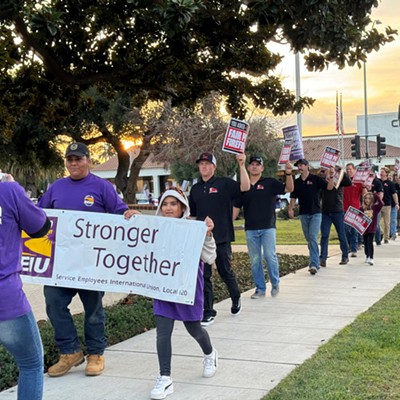After 17 people were killed in a school shooting in Parkland, Florida, on Feb. 14, several major national gun retailers, including Dick’s Sporting Goods and Walmart, recently announced increasingly stringent firearm sales policies.
Dick’s, which opened its first Santa Maria store on Feb. 23, was the first to make its changes public.
In a media statement posted to its corporate website on Feb. 28, Dick’s Chairman and CEO Edward Stack announced that the retail chain will no longer sell firearms to anyone under the age of 21 and will stop selling high-capacity magazines effective immediately. He also said “assault-style rifles,” which had already been removed from all Dick’s stores after the Sandy Hook Elementary School shooting in 2012 but were still available at Dick’s subsidiaries, will no longer be sold at any stores affiliated with Dick’s.
Stack’s decision was in direct response to the Parkland shooting and its survivors’ calls for gun policy reforms. In the statement, Stack called on lawmakers to pass similar “common sense” policies and regulations.
“Some will say these steps can’t guarantee tragedies like Parkland will never happen again,” Stack said in the statement. “They may be correct—but if common sense reform is enacted and even one life is saved, it will have been worth it.”
Several major retail chains have already followed suit—Walmart released a statement on Feb. 28, saying its stores will no longer sell firearms to individuals under the age of 21. L.L. Bean announced the same policy change a few days later.
John Dwyer, vice president of the Santa Maria Gun Club, said implementing laws similar to the new restrictions in place at Dick’s would be a mistake.
“I’m not supportive of Dick’s stance,” Dwyer told the Sun, “and I’m not supportive of all these NRA [National Rifle Association] bashers.”
An altogether ban on “assault weapons” would be nothing more than an unclear policy, Dwyer said, because any gun, or even any object, used to harm an individual could technically be classified as an assault weapon. The AR-15, he said, a semi-automatic rifle used in many of the country’s most highly publicized mass shootings, has a worse reputation than other rifles simply because of its aggressive-looking design.
Dwyer said he is also against raising the firearm purchasing age restriction to 21. If 18-year-olds and 17-year-olds with consenting parents are mature enough to join the military and handle fully automatic firearms, they should be considered old enough to buy sporting rifles, Dwyer said.
In addition to his work with the Santa Maria Gun Club, Dwyer is a member of the NRA, a licensed NRA gun safety instructor, and a licensed firearms dealer. He sells about 50 guns a month out of his home, where Dwyer said he has conducted his retail business for years to avoid overhead costs.
Although Dwyer said he has no intention of putting sales restrictions on legal weapons or legal buyers under 21, he does believe the U.S. should require some form of gun safety training for individuals who hope to purchase firearms.
“I’ll catch some flak over that one,” he said with a laugh, adding that he frequently refuses to sell to potential customers lacking gun safety training. “I don’t believe anybody should be able to buy a gun if they haven’t gone through a training class.”
While in some states, including California, buyers are required to obtain a firearm safety certificate before legally purchasing a gun, Dwyer said the process of getting a certificate includes little more than a written exam. That process, he said, should be amended to more closely resemble the driver’s education process required before obtaining a license.
Still, Dwyer said the most productive changes possible would be to the mental health care system. In many shootings, including the Parkland case, the shooters were known to have mental health issues long before their crimes were committed, he argued.
“It’s horrible the way this country has gone with people lashing out violently for no real reason,” Dwyer said. “But I honestly believe that it’s not a gun problem, it’s a mental health problem.”
It’s both, according to Congressman Salud Carbajal (D-Santa Barbara), who recently reintroduced the Gun Violence Restraining Order Act to the U.S. House of Representatives on Feb. 28. The bill would provide grant funding to states committed to passing and implementing gun violence restraining order laws similar to those already existing in a few states, including California.
California enacted gun violence restraining orders in 2014 after the Isla Vista shooting, Carbajal said in an interview with the Sun. The orders, which can be requested through court by close family members or law enforcement officials, temporarily stop individuals who pose a threat to themselves or others from purchasing or possessing guns.
The orders give family members and law enforcement officials a tool to prevent gun violence while also providing due process, Carbajal said. A gun violence restraining order can ultimately only be issued by a judge, and that decision can be appealed.
Gun violence restraining orders can be useful in a variety of situations, according to the Santa Barbara County Sheriff’s Office. The orders were issued eight times in Santa Barbara County in 2016, and guns were temporarily taken from several county residents, some with suicidal tendencies, one in the midst of an ongoing domestic dispute, and one Carpinteria woman who had previously threatened to shoot her coworker.
The Gun Violence Restraining Order Act has gained significant congressional support from both sides of the aisle this time around, Carbajal said, but whether or not it has enough to actually pass is still unclear.
“I think this is a common sense gun safety law that I hope can move forward,” Carbajal said.
Staff Writer Kasey Bubnash can be reached at [email protected].










